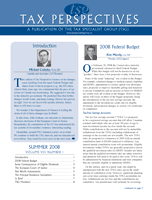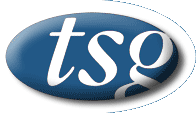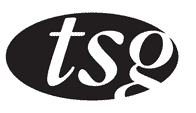
PDF Format
 Issue Contents Issue Contents
 All Issues All Issues
Summer 2008
Volume 8, Number 1
The information in Tax Perspectives is prepared for general interest only. Every effort has been made to ensure that the contents are accurate. However, professional advice should always be obtained before acting and TSG member firms cannot assume any liability for persons who act on the basis of information contained herein without professional advice.
Some Consequences of Eligible Dividends
By W. P. Daye, FCA, TEP
Daye & Company (Edmonton)
In the Spring 2006 issue of Tax Perspectives, Maureen Cush reviewed the then new rules regarding eligible dividends. That article addressed the mechanics of those rules and the resulting reduced tax rates for eligible dividends. The focus of this article is on some of the issues and planning opportunities, primarily for Canadian Controlled Private Corporations ("CCPCs") that have been identified from working with this new system.
Bonus vs. High-Rate Corporate Tax
In prior years, it was common for corporations to declare bonuses to pay out income that exceeded the Small Business Limit; otherwise, this income was taxed at the highest corporate tax rate, causing significant double tax when dividends were paid. When the eligible dividend rules were introduced for 2006, much of the double tax was eliminated. Consequently, owners of corporations must now reconsider whether to declare bonuses or retain the income in the corporation. This decision can be impacted by many factors, including the future income projections for the shareholder. For 2007 it was relatively clear that in certain provinces (e.g., Alberta) the bonus alternative was preferable. That is less clear in other provinces, especially for 2008 and subsequent years where the opposite conclusion appears likely.
Cyclical Businesses and the Bonus/ High-Rate Corporate Tax Decision
In businesses that were subject to cyclical fluctuations, the strategy of paying bonuses could be flawed. Suppose bonuses were declared in one year and taxed at a high tax rate in the shareholder's hands, and in the subsequent year the business suffered a loss. In that scenario, the loss could only be carried back against "low rate" tax in the corporation and could not be used to recover the high-rate tax paid by the shareholder.
The introduction of the eligible dividend rules should make it more attractive for cyclical businesses to reduce bonuses and pay high-rate corporate tax. In situations where the corporation may encounter losses in any of the three succeeding years, consideration should be given to having some income taxed at the high rate, thereby making it easier to recoup the high-rate corporate tax by carrying back losses.
Interplay of Eligible Dividends and RDTOH ("Refundable Dividend Tax on Hand")
In most cases, it makes sense to pay sufficient taxable dividends to trigger a refund of RDTOH because the shareholder's tax is less than the refund received by the corporation. This provides an immediate cash flow advantage, and a longer-term capital gain advantage as the value of the shares is reduced by the payment of the dividends.
When eligible dividends can be paid, the cash flow advantage is enhanced as the spread between the shareholder's tax and the corporation's refund is widened.
In some situations, it may be advisable to pay high-rate corporate tax on business income to facilitate the payment of eligible dividends where a refund of RDTOH is being sought.
Charitable Donation Strategies
Where a corporation makes a charitable donation, it can have an adverse effect on the General Rate Income Pool ("GRIP"), which is the pot from which eligible dividends are paid. Accordingly, this situation needs to be analyzed carefully and it may be better in some cases for the individual shareholder to make the donations.
Pending Change of Control
Where a corporation is sold to a non-resident or public company purchaser, there may be a change of control when the share purchase agreement is signed. This change of control can have an adverse effect upon a pre-sale dividend payment strategy. Note that issuing rights to acquire shares can also impact this strategy.
Corporate Contributions through Amalgamation or Wind-Up
The GRIP and related balances for each of the merging corporations need to be reviewed to determine the account balances that will be available post-merger. In some cases, remedial action will need to be taken prior to the merger to preserve the balances.
Estates Holding Shares of Closely Held Corporations
Prior to the introduction of the eligible dividend rules, a so-called "pipeline" strategy was often employed to minimize the taxes triggered upon death. The object was to ensure that capital gains were triggered rather than dividends, as the tax rate on capital gains was usually lower than the tax rate on dividends. Now that the tax rate on eligible dividends approximates the tax rate applicable to capital gains in some provinces, this strategy needs to be reviewed carefully in light of the particular facts and circumstances.
Asset Sales vs. Share Sales
For many years vendors have favored the sale of shares rather than assets because the tax on capital gains was lower than the tax arising from the sale of assets. With the new eligible dividend regime there are many situations where there is no significant difference in the tax cost under either scenario. As purchasers usually have a strong preference for purchasing assets, careful analysis may reveal little tax burden to the vendor, which may make it easier to consummate a sale of the business.
Summary
The introduction of the eligible dividend rules has added a measure of complexity to many aspects of tax planning for corporations and their shareholders, particularly owner-managed businesses. Some of the old "rules of thumb" must now be discarded and replaced by a careful analysis of the facts in each situation. As there are significant variations between provinces in both corporate and personal tax rates, different results and conclusions may be obtained, depending upon the particular province where business is carried on and where an individual shareholder resides.
| 




